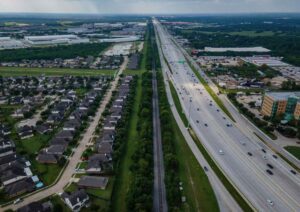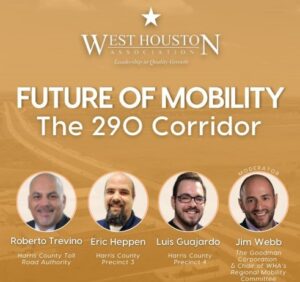 The U.S. 290 Corridor is entering a pivotal chapter in its story. Long regarded as a lifeline out of Houston and a gateway to the communities of northwest Harris and Waller Counties, it is now feeling the weight of rapid population growth, expanding freight needs, and new commercial development. What once seemed a far-off challenge has become an immediate priority: how do we ensure 290 remains a corridor of opportunity rather than a source of frustration?
The U.S. 290 Corridor is entering a pivotal chapter in its story. Long regarded as a lifeline out of Houston and a gateway to the communities of northwest Harris and Waller Counties, it is now feeling the weight of rapid population growth, expanding freight needs, and new commercial development. What once seemed a far-off challenge has become an immediate priority: how do we ensure 290 remains a corridor of opportunity rather than a source of frustration?
From its earliest days, the West Houston Association (WHA) has helped shape how our region grows by championing infrastructure that balances economic vitality with livable neighborhoods. Our advocacy for the original I-10 expansion was WHA’s first major undertaking, and its lessons still resonate. Today, the same spirit of foresight is guiding conversations about U.S. 290, Hempstead Highway, and the supporting network that keeps West Houston moving.
U.S. 290 is far more than a highway. It is the spine of a rapidly growing northwest market that includes Jersey Village, Cypress, Waller, and a constellation of master-planned communities. It connects distribution centers to the Port of Houston, moves students to Prairie View A&M University, and serves as an essential evacuation route when hurricanes threaten. Its health directly affects the daily lives of hundreds of thousands of residents and the competitiveness of employers throughout the corridor. Recent TxDOT expansions improved capacity, but they did not knit together the multiple agencies responsible for mobility. Bottlenecks persist, transit remains limited, and planning efforts are often fragmented.

Forecasts show that over the next 10 to 20 years, tens of thousands of additional vehicles will enter the corridor each day. By 2050, TxDOT’s own estimates suggest that even the highest existing capacity will not meet projected demand.
As we consider what comes next, the Katy Freeway offers a cautionary tale. After a record-setting widening, I-10 initially delivered shorter travel times, only to see congestion rebound as growth and new trips filled the lanes. The lesson is clear: building the “biggest highway” does not guarantee long-term reliability. Future work on 290 must focus on smarter, not simply bigger, solutions; investments that manage demand, comprehend future technologies, support transit, and integrate land use and resilience. 
Parallel to 290, Hempstead Highway represents an untapped opportunity. HCTRA and TxDOT are exploring ways to modernize this route, potentially adding managed lanes that balance throughput with reliability. Managed facilities could include dynamic tolling to preserve travel speeds, express bus or BRT priority, and features that keep freight moving safely. Elevating portions of the corridor and hardening drainage could also protect against flooding, ensuring that critical routes remain open during storms. A system designed to reward shared and zero-emission trips aligns with both congestion management and environmental goals.
The stretch from the Harris County line to the Grand Parkway is booming with new neighborhoods, schools, and logistics hubs. Without thoughtful planning, today’s pressure will harden into tomorrow’s gridlock. The corridor needs a package of improvements: a phased Hempstead managed-lane spine; express bus or BRT services that connect park-and-rides and major campuses; coordinated ramp and frontage upgrades where SH-99 meets 290; and local access management that keeps freight, shoppers, and students moving without sacrificing safety. Resilience must be part of the blueprint. Elevating low segments, improving stormwater outfalls, and adding real-time closure systems can protect the corridor and keep evacuation routes functional when needed most.
Delivering these solutions will require a blend of funding sources and strong cooperation among TxDOT, HCTRA, METRO, counties, cities, and the private sector. Public-private partnerships can align investments around key nodes, while corridor-wide access agreements can trade driveway consolidation and site-design commitments for predictable mobility performance. Equally important is a shared commitment to measure success by people moved, reliability achieved, and crashes prevented, not just by lane miles constructed.
WHA’s upcoming forum on the 290 Corridor invites stakeholders to look beyond pavement and focus on outcomes: shorter commutes, dependable freight delivery, safer frontage roads, and equitable access to jobs and education. Together we can ask, and answer, the questions that will define the next generation of mobility in Northwest Houston: how do we design a system flexible enough to perform in 2035 and 2045, not just in 2028; what balance of priced lanes, transit frequency, and HOV policy best moves people during peak periods; and how can public and private partners coordinate to deliver projects that respect both budgets and community character?
U.S. 290 has always been a corridor of promise. With thoughtful planning, smart investment, and broad collaboration, it can remain a place where mobility meets opportunity and growth meets responsibility. WHA is proud to help lead that conversation, and we invite you to join us in shaping a future where the 290 Corridor continues to support thriving neighborhoods, resilient infrastructure, and a vibrant regional economy.

